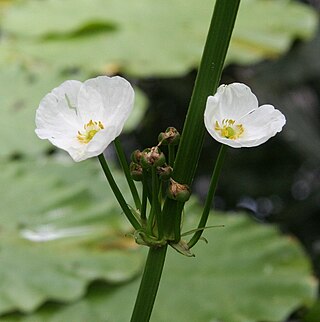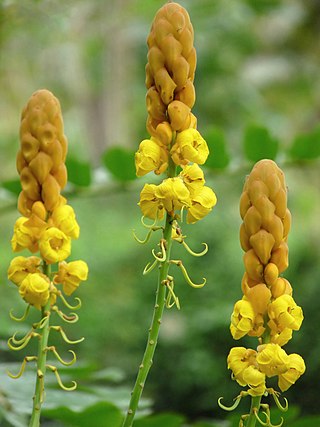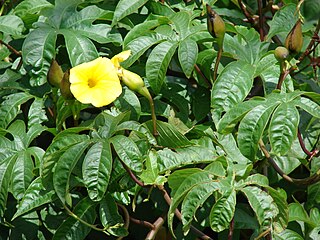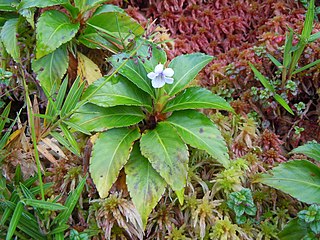
Genipa is a genus of trees in the family Rubiaceae. This genus is native to the American tropical forests.

Calocedrus, the incense cedar, is a genus of coniferous trees in the cypress family Cupressaceae first described as a genus in 1873. It is native to eastern Asia and western North America. The generic name Calocedrus means "beautiful cedar".

Dysphania ambrosioides, formerly Chenopodium ambrosioides, known as Jesuit's tea, Mexican-tea, payqu(paico), epazote, mastruz, or herba sanctæ Mariæ, is an annual or short-lived perennial herb native to Central America, South America, and southern Mexico.

Falconeria is a monotypic plant genus in the family Euphorbiaceae, first described as a genus in 1839. The genus is sometimes included within the genus Sapium. The sole species is Falconeria insignis. The plant is found from India, Nepal, Bangladesh, and Sri Lanka to Indochina, China, Thailand and Peninsular Malaysia.

Echinodorus subalatus is a species of aquatic plants in the Alismataceae. It is native to Cuba, Mexico, Central America, Guyana, Venezuela, Bolivia, Brazil and Paraguay. It is found naturally growing in mud by the side of streams.
Awakatek is a Mayan language spoken in Guatemala, primarily in Huehuetenango and around Aguacatán. The language only has fewer than 10,000 speakers, and is considered vulnerable by UNESCO. In addition, the language in Mexico is at high risk of endangerment, with fewer than 2,000 speakers in the state of Campeche in 2010.

Senna alata is an important medicinal tree, as well as an ornamental flowering plant in the subfamily Caesalpinioideae. It also known as emperor's candlesticks, candle bush, candelabra bush, Christmas candles, empress candle plant, ringworm shrub, or candletree. A remarkable species of Senna, it was sometimes separated in its own genus, Herpetica.

Paul Carpenter Standley was an American botanist known for his work on neotropical plants.

Lenzites is a widespread genus of wood-decay fungi in the family Polyporaceae. It was circumscribed by Elias Magnus Fries in 1835. The generic name honours German naturalist Harald Othmar Lenz (1798–1870).

Schizachyrium is a widespread genus of plants in the grass family. The name is derived from the Ancient Greek words σχίζειν, meaning "to split," and ἄχυρον, meaning "chaff." It refers to either the glume or the toothed lemmas.

Distimake tuberosus, also known as Spanish arborvine or wood rose, is a vine in the family Convolvulaceae. It is native to the Americas, from Florida and Texas to Brazil, although considered by the USDA as introduced to the United States. It is an invasive species in a number of islands in the Indian and Pacific Ocean, such as New Caledonia.

Violence against women in Guatemala reached severe levels during the long-running Guatemalan Civil War (1960-1996), and the continuing impact of that conflict has contributed to the present high levels of violence against women in that nation. During the armed conflict, rape was used as a weapon of war.

Sagittaria australis, the Appalachian arrowhead or longbeak arrowhead, is a plant species native to much of the eastern part of the United States, from Louisiana to Iowa to New York State to Florida, mostly between New Jersey and Mississippi with scattered locations elsewhere in the range.
Albidella is a genus of plants in the Alismataceae. At the present time, only one species is known, Albidella nymphaeifolia, formerly called Echinodorus nymphaeifolius. It is native to Cuba and the Yucatán Peninsula.

Cathestecum is a genus of the North American plants in the grass family.
Eremitis is a genus of bamboo plants in the grass family, that is endemic to Brazil.

Viola stipularis, is a species of violet that grows in southern Central America, some Caribbean islands and northern South America; from Costa Rica and Guadeloupe south to Peru.
Celtis schippii is a medium-sized evergreen tree native to the lowland rainforests of Central and South America. It grows up to 10–20 meters high.
Strobilanthes penstemonoides is a species of flowering plant in the family Acanthaceae. It occurs in China, Bhutan, India, and Nepal. Its specific epithet has been spelled as penstemonoides, pentstemonoides, and pentastemonoides.
Sofya Georgiyevna Tamamshyan (1901–1981) was a Russian-Soviet botanist and plant taxonomist noted for describing 7 genera and more than 50 species, and for authoring over 120 works. The standard author abbreviation Tamamsch. is used to indicate this person as the author when citing a botanical name.













